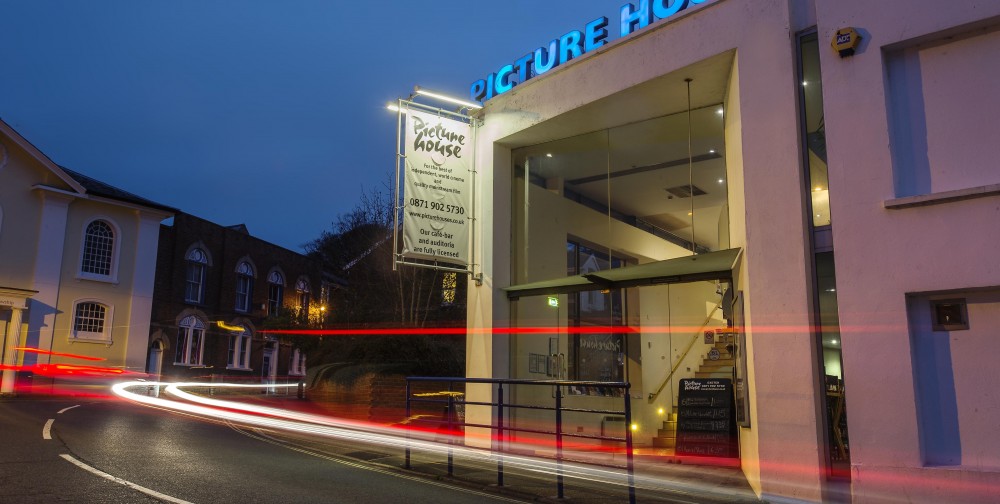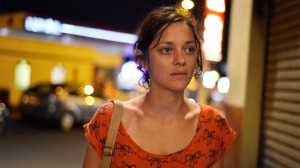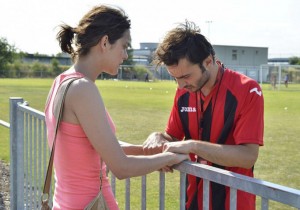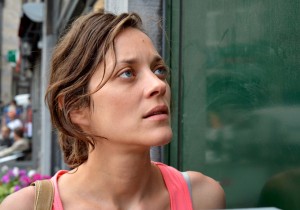Our next Screen Talks event will be on Monday 1st December, 6.00pm at Exeter Picturehouse. Dr Jamie Steele, Lecturer in European Cinema, Dept of English and Film Studies at the University of Exeter) will introduce Two Days, One Night (Jean-Pierre Dardenne, Luc Dardenne, 2014).
Join the event on Facebook and find out more here.
Booking Information: Book online, call the Box Office 0871 902 5730 or buy tickets on the door (half price for students on Mondays).
Jamie has written a guest-blog post for us on the film:
In 2005, the Dardenne brothers became part of a select group of only seven filmmakers to have won the Cannes film festival’s Palme d’Or on more than one occasion. They have received the prestigious award on two occasions – the first for Rosetta in 1999 and the second for L’enfant/ The Child. The Dardenne brothers were the first – and to date the only – Belgian filmmakers to win the top prize at Cannes. However, their first Palm d’Or success was seen as controversial. The 1999 Cannes film festival was described as the worst festival ever after two films that were produced on low budgets with non-professional actors – Rosetta by the Dardenne brothers and L’humanité/ Humanity (Dumont, 1999) – dominated the awards. The Dardenne brothers have since become the most internationally recognized Belgian filmmakers – Chantal Akerman and Jaco von Dormael aside. In 2007 – to mark the 60th anniversary of the Cannes film festival – the Dardenne brothers were invited to contribute to the omnibus film Chacun son Cinéma/ To Each his own cinema (2007). The Cannes film festival has certainly provided a platform for the francophone Belgian filmmakers to develop an international reputation amongst cinephile audiences.
The Dardenne brothers have formed a substantial part of my research interests – and their films were very much an entry point for me in terms of discovering films produced in the francophone Belgian region of Wallonia. I vividly remember my first viewing of Rosetta in 2001 – a film that showed a young woman who desperately fights for employment as she treks between a caravan park and the grey and bleak streets of Seraing’s town centre. After the film’s release, the Belgian parliament voted in a law – widely known as the ‘Rosetta Plan’ – that was designed to combat social exclusion and to improve youth employment rights in the most deprived and depressed Belgian towns.
Jean-Pierre and Luc Dardenne were born in small towns (Engis and Awirs) in the Liege province, and grew up in the town of Seraing. The brothers also went and studied at higher education level in Louvain – Jean-Pierre studied art dramatique at IAD (Institut des arts dramatiques) and Luc completed a degree in Philosophy at UCL (Université catholique de Louvain). Whilst on a placement working for the French playwright Armand Gatti from the IAD, Jean-Pierre began to work and experiment with video. With his brother Luc, the Dardennes founded their own production company, Derives, to produce their six video documentaries, one short film, and two feature films between 1978 and 1992.
The town of Seraing has been ever present in their films from the video documentaries of the 1970s through to Deux jours, une nuit (2014) – with the exception of Le silence de Lorna (set in the neighbouring city, Liège). Seraing is a small industrial town, situated within the province of Liège, which was formerly dominated by factories, mines, and the industrial traffic that travelled along the river (La Meuse). The early video documentaries broadly dealt with the workers’ memories of collective struggles and protests against the closing down of the factories in Seraing – in particular the closure of the Cockerill plant – and the subsequent loss of employment in the area. Social issues have been subsequently foregrounded in the Dardenne brothers’ second phase of filmmaking (post-1996) – particularly themes of marginalization, social exclusion, social fracture, sentiments of abandonment, and a loss of a ‘regional’ working class identity.
Articles and reviews produced by The Guardian, Cahiers du Cinéma, and Positif on Deux Jours, Une Nuit all draw comparisons with the aforementioned Rosetta. There are particular similarities – certainly the theme of (un-)employment and the focus on a central female protagonist who is fighting for her job. However, Luc Dardenne notes a key difference between the two characters through his analysis of Rosetta, by stating that she is ‘a good little soldier of capitalism’ (L. Dardenne, in Stevens, 2014). Rosetta is implicated in a struggle for employment and a sense of belonging in – what the Dardenne brothers call in their journal – ‘the fortress of society’. She understands the notion of high levels of competition between young people in the region for jobs in a neoliberal economy. The society has become increasingly atomized and fragmented – once Rosetta loses her job, she is immediately replaced. The individual is isolated and s/he is fighting against her/ his peers for limited opportunities. As the Dardenne brothers note in their journal, Rosetta is ‘un soldat en guerre’ [a soldier in action]. She is clearly willing to fight and compete, whereas Marion Cotillard’s character of Sandra – in Deux Jours, Une Nuit – has a more sombre and uncertain attitude towards competition. For Sandra, her mission is to foster a sense of understanding and support from her colleagues. She is attempting to re-create a sense of collective and solidarity amongst the workers – in support of her and one another.
It is also important to acknowledge that these two films are produced fifteen years apart, and the socio-political context has changed. In the late 1990s, Rosetta is discussed – in academic scholarship – as part of so-called French New Realism. The comparison of their films at this time to French New Realism is particularly apposite, given that there are similarities in the social-political issues that are explored on screen and the film style that the Dardenne brothers use. In an interview in Sight and Sound (Stevens, 2014), the two filmmakers cite influences from real events that took place in France in the 1990s in which workers were asked to vote to keep their bonuses. That said, the filmmakers widely note that the idea resurfaced after 2008 and the economic crisis in the USA and Europe. In essence, we are witnessing a film that is dealing with a social crisis in a contemporary context of economic crisis with high levels of unemployment in a micro-geographical area – that of Seraing.
In his journal, Luc Dardenne sets out the filmmakers’ own style after the critical failure of their second feature film Je pense à vous/ You’re always on my mind (1992). This proves to be a significant turning point in the filmmakers’ career. The film style begins with La promesse/ The Promise (1996) and persists through to this year’s film, Deux Jours, Une Nuit (2014). In this period, the filmmakers have released a film every three years – Rosetta (1999), Le fils/ The Son (2002), L’enfant/ The Child (2005), Le silence de Lorna/ Lorna’s Silence (2008), Le gamin au vélo/ The Kid with a Bike (2011). The Dardenne brothers’ film style includes the use of handheld camera, filming ‘close-up’, the camera following the movements of the body, the use of non-professional or unknown actors, no use of non-diegetic music, and the films are produced on a low budget.
We can tease out some of the continuities in their film style in Deux Jours, Une Nuit – particularly in terms of the camerawork and editing. For example, the Dardenne brothers’ handheld camera focuses on the corporeal movements of the central protagonists, tracing their paths through Seraing. Deux Jours, Une Nuit is characterized by the use of long takes and repetitions of movement and dialogue. We can begin to think about the film as constructed – in part – of a series of long takes that follow Sandra in real time as she asks her colleagues for a sense of understanding and solidarity. The long takes encourage the spectator to observe the interaction between Sandra and her colleagues in each exchange. Each long take draws attention to the subtle nuances of the body’s movement in the space. At the same time, the camera is not static, but instead moves in a corporeal manner and is in perpetual motion. The mechanism moves behind the body on screen – at times – as if there are strings attached between the camera and the central protagonist.
There are, however, deviations from this style – particularly in Le gamin au vélo – in which the Dardenne brothers use non-diegetic music and cast the well-known Namurois actress Cécile de France. We once again see a deviation from this imposed restriction on their films with the decision to cast the even better known and internationally recognised French star Marion Cotillard as Sandra. The Dardenne brothers met the French star when they were producers on the French film De rouille et d’os/ Rust and Bone (Jacques Audiard, 2012) in which Cotillard plays Stéphanie – a killer whale trainer who loses her legs after a horrible accident. The filmmakers considered many roles for the French star – including casting her as a doctor working in Seraing’s suburbs – before writing the role of Sandra, a young worker in a solar panel factory who was on leave from her job due to depression.
Each film’s budget has also increased alongside the Dardenne brothers’ reputation over the past two decades. Luc Dardenne’s ‘low budget’ idea is certainly the case for their first feature film post-1996, as La promesse cost only 1.6 million Euros (the equivalent in Belgian francs at the time). Deux Jours, Une Nuit has the largest budget for the Dardenne brothers to date at 6.9 million Euros. The filmmakers once made the ludic remark that a filmmaker could not produce a film in Belgium without pooling finance together in the form of co-productions. These filmmakers have created all of their films post-1996 through agreements with France – and Deux Jours, Une Nuit is no exception. The breakdown of co-production finance is balanced between Belgium (46%) and France (44%) in this film to such an extent that the categorization of the film’s ‘nationality’ has been reported differently across several publications. In particular, Cahiers du Cinéma classify the film as ‘France, 2014’ and Positif as ‘Belgium, 2014’. That said, academic scholarship on the Dardenne brothers has previously considered the work of the Dardenne brothers in the context of French cinema – particularly if we think about the filmmakers’ inclusion in O’Shaughnessy’s (2007) The New face of Political Cinema: Commitment in French Film since 1995 and Austin’s (2008) Contemporary French Cinema.
Deux Jours, Une Nuit wonderfully captures the plight of a young woman, worker, and mother who is caught in a precarious situation. With the limited time frame of only one weekend, she is encouraged to “resist” – the verb Luc Dardenne uses to open his journal – by persuading her colleagues to give up their hard-earned bonus.
Deux Jours, Une Nuit was released in cinemas in May 2014 in Belgium and France and in August 2014 in the UK.
Works Cited:
Austin, G. (2008) Contemporary French Cinema: an introduction, 2nd edition, Manchester: Manchester University Press
Dardenne, L. (2008) Au dos de nos images, Paris: Editions du Seuil
Delorme, S. (2014) ‘La pitié dangereuse’, Cahiers du Cinéma, June. pp. 44-45
O’Shaughnessy, M. (2007) The New Face of Political Cinema: Commitment in French Film since 1995, New York: Berghahn Books
Nuttens, J-D (2014) ‘L’affaire humaine’, Positif (639), May. pp. 8-15
Stevens, I. (2014) ‘Woman on the verge’, Sight and Sound, September. pp. 65-67
Dr Jamie Steele lectures in Film Studies at the University of Exeter. His current research interests include the regional and the transnational in Belgian Cinema.






